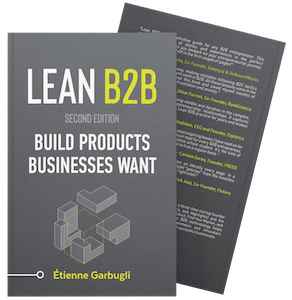
In B2B, your beachhead market should be worth at least $10M…
What does that mean actually?
The measure typically used for market sizing is the Total Addressable Market or TAM.
It’s basically the amount of annual revenue you could earn if you achieved 100% market share in your beachhead market… which is… not usually realistic.
Notice, I wrote “annual revenue”. It’s important to understand that TAM is not a number of customers but rather dollars per year. Willingness to pay is key. In this post, we’ll look at how to calculate total addressable market for a B2B startup.
You get your market’s TAM by multiplying the total number of users by the revenue per user. For example, if you have 10,000 customers and you can charge up to $10,000 per year, your TAM is $100M. It’s starting to be a big opportunity.
For your beachhead market, you should aim for a TAM of $10 to 100 million. If it’s more than that, it makes sense to segment it a bit further. If it’s less, your beachhead market may not be worth going after considering it’s highly optimistic to think you’ll get 50% of the market.
Therefore, it’s important to pick a market segment of the right size. You want to get enough word of mouth recognition within your beachhead to become the market leader.
Now there’s many ways to build a $100M market:
- You can get 10 customers paying you $10M per year;
- You can get 1,000 businesses to pay you $100k per year;
- Or you can get $100M customers paying you $1 each year.
As entrepreneur Tim Ferriss says, higher pricing means that you can sell fewer items and manage fewer customers; it’s a way to focus the business.
Now, before getting started, let’s consider the limitations of TAM.
Total Addressable Market vs. Serviceable Obtainable Market, Which is Best?
As we said, unless you have a monopoly or unlimited financial resources, capturing 100% of the TAM is almost impossible.
Although investors usually work with TAM, a better measure of a market is SOM or Serviceable Obtainable Market. SOM is a good reminder that we need to factor in:
- Competition
- Geography
- Culture
- Regulations
- Financial limitations
- Willingness to pay
- Market cannibalization
- Resources – How many customers can we realistically support?
Those are all limits we must understand to properly assess market segments.
For example, messaging app WhatsApp is banned in some countries. Its TAM probably includes China… which makes its TAM bigger than its SOM. Same with Facebook.
For SOM, it’s a good idea to handpick geographies or markets and assign a targeted market share percentage based on local competitive environments.
But, let’s get back to our total addressable market.
There are three ways to calculate TAM:
- Top-down;
- Bottom-up;
- Referring to external research.
Let’s take a look at each approach.
Plan Your Market Expansion – Download our Market Expansion Roadmap FreeReferring to External Research
Now, the easiest thing to do is to refer to external research.
Has Gartner, Forbes, Forrester Research, Marketing Sherpa, or another credible analyst published market estimates? If so, can we base our assumptions on those data points?
Depending on your market thesis, this may not be best for your business.
If there’s already a market research report out there with all the information you need, it might be too late to tackle the opportunity.
What you probably want to do is a Top-down or a Bottom-up sizing.
Top-down Analysis of your Total Addressable Market
The top-down approach uses secondary market research to define a subset of customers unified by the characteristics of your market.
Usually, to calculate your total addressable market, you start with a large number and then narrow it down based on the criteria of your segment. Hence, top-down.
You need to find the data related to the variables and criteria used for your market segmentation. For example, if you provide a product to business travellers. You’d first look at the country population, then look at active population, then at the age of active population travelling once a year, once a month, once a week, etc.
You could use data from:
- Government data and census surveys (E.g. data.gov or data.europa.eu)
- Directories, trade groups and industry analytics
- Worldwide Financial and Economic data sources like Quandl
- Bureau of Labor Statistics
- Or various sub-market data
As you do, it’s a good idea to take note of your hypotheses. It helps manage uncertainty and gives you base assumptions to go and validate.
You can use this template for Top-down (or Bottom-up) TAM calculations.
Total Addressable Market Bottom-up Analysis
Now, the best way to calculate your total addressable market is through a bottom-up analysis – also called ‘counting noses’.
It starts with your market thesis and your primary market research – interviews, surveys, willingness to pay – looking at the users fitting your customer profile.
For a bottom-up analysis, you determine the local market size – how many people fit in your local target market – and then extrapolate that to a wider population.
For example, you’d start with your current ideal customers, figure out how many companies in your region fit that profile and then expand that globally.
Bottom-up analyses are perceived to be more accurate, because they’re anchored around proven data points that can be magnified to uncover the whole TAM population.
Again, you want to map your hypotheses for this analysis.
What Makes a Good Total Addressable Market
As a rule of thumb, you need to go as deep as needed to be able to make only defensible assumptions – However, if you’re off by 20%, it’s good enough.
So, once you’ve ran the numbers, what do you get?
Your TAM will be larger than your SOM because it includes all the markets you don’t serve or can’t target yet.
So, let’s keep in mind that you’ll have a hard time getting 50% of those segments within a reasonable time frame.
Anything under $5 million per year can be a problem. It will make it difficult to convince investors that your market is worth tackling.
Anything over $1 billion raises flags. You need to refine your assumptions until the market size makes sense.
Once you ran the number for your market segment, it’s time to get out of the building and validate that market. Let’s do it!
Plan Your Market Expansion – Download our Market Expansion Roadmap FreeMore on TAM Calculations
- 4 Techniques and 6 Tools to Find your TAM
- Modeling Addressable Market
- How Eight Successful Startups Explained their Addressable Markets to Investors
- How to Miss By a Mile: An Alternative Look at Uber’s Potential Market Size
Download the First 4 Chapters Free
Learn the major differences between B2B and B2C customer development, how to think about business ideas, and how to assess a venture’s risk in this 70-page sampler.
Working on a B2B Startup?
Join our free email course to learn all you need to know:


